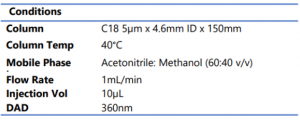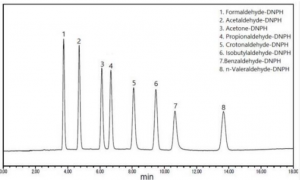Analysis of 2,4-DNPH Derivatised Aldehydes by HPLC-DAD
Introduction
Aldehydes are important compounds regularly use in the chemical industry. Sick house syndrome is a medical condition caused by poor air quality in enclosed indoor spaces and the presence of specific volatile organic compounds (VOCs) such as formaldehyde. It is vital that the level of formaldehyde and associated compounds are regularly measured and controlled especially in working environments in which formaldehyde is handled.
SCION Instruments developed a method for the simultaneous analysis of seven DNPH (2,4- Dinitrophenylhydrazine) derivatized aldehydes plus one derivatized ketone.
Experimental
A SCION LC 6000 with DAD was used with a C18 reverse phase column for the simultaneous identification of eight target compounds. An analytical standard containing all target analytes was analysed to demonstrate identification and separation of all compounds.
An ambient air sample was collected in a trap tube filled with silica gel which contained 2,4-DNPH. The aldehydes and ketone present in the ambient air were collected on the trap and derivatized before being eluted with acetonitrile and analysed.
Table 1. Details the analytical conditions of the HPLC-DAD

Figure 1 shows the chromatogram of all target compounds analysed at 0.5mg/L, along with peak identifiers.

Figure 1. 7 DNPH aldehydes and 1 DNPD ketone (0.5mg/L)
Results
As shown in Figure 1, all target analytes were completely resolved from each other in under 15 minutes.
Limit of detection studies were completed for Formaldehyde and Acetaldehyde. The limited of detection for Formaldehyde in ambient air was 0.02µg/m3 and 0.1µg/m3 for Acetaldehyde, respectively.
Conclusion
SCION Instruments offers an easy solution for the simultaneous identification of seven DNPH derivatized acetaldehydes and one DNPH derivatized ketone using the SCION 6000 HPLC-DAD
system. Complete separation and low detection limits were observed when ambient air samples were analysed.
Download Application Note
For a PDF copy download the application note using the following link: Analysis of 2,4-DNPH Derivatised Aldehydes by HPLC-DAD
